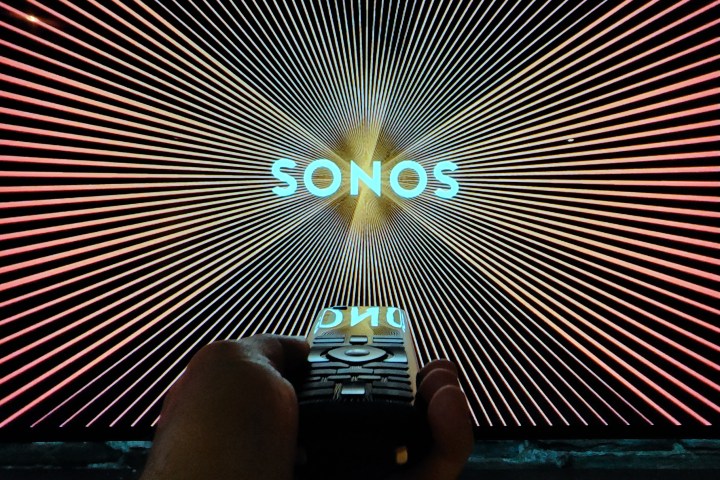
In 2023, rumors regarding a possible Sonos TV device picked up steam when Bloomberg’s Mark Gurman reported that the company had plans to release a dedicated streaming box priced around $150 to $200. The device, code-named “Pinewood,” according to Gurman’s unnamed sources, will handle 4K video, along with Dolby Atmos and Dolby Vision. Now, thanks to a previously unreported Sonos patent application unearthed by Janko Roettgers, we know a bit more about how such a Sonos TV device might work, including one very disconcerting detail: it may lack a physical remote control.
The patent application, which goes into exhaustive detail describing the Sonos ecosystem as a whole, places a special emphasis on the role of smartphones as the way we would interact with an as-yet-unreleased Sonos TV streaming device. And yes, in the application, it’s actually called Sonos TV.
A new version of the Sonos app (or possibly a separate Sonos TV app) would be used for the setup and control of a Sonos TV. It would include access to streaming apps and a host of related features like social sharing with friends and the ability to make deep dives into related media like music and games. Like many existing media streamers (Apple TV, Roku, Fire TV, etc.), the app would include a pop-up interface for navigation and voice control (via your phone or any compatible microphone-equipped device). But unlike these other devices, Sonos’ application doesn’t mention the existence or use of a dedicated physical remote.
We reached out to Sonos for comment. Unsurprisingly, this is the statement we received via email: “We’re in a perpetual state of invention at Sonos, building on the 3000+ patents we have to date. You will continue to see us deliver new inventions, some in categories we’re in, some in categories we could envision entering in the future. We don’t share details on our patents or future road map.”
That’s also exactly what Roettgers was told when he asked.
An understandable choice
A streaming device without its own remote isn’t a new idea. The original Google Chromecast was 100% reliant on a phones to do its thing (though it was never really meant to actively control what you’d see on the TV). Google retired the concept after the Chromecast Ultra, switching to the remote-equipped Chromecast with Google TV as its current vision of what a full-fledged streaming device should look like.
You can partially understand why Sonos might want a remote-less Sonos TV. So far, the company’s entire ecosystem of wireless multiroom audio products has been designed to work through the Sonos app — either from a smartphone, tablet, or computer. Third parties have created Sonos-compatible remote controls like Ikea’s Symfonisk Music Remote, but Sonos itself has stuck steadfastly to its remote-free philosophy (which also keeps costs down).
There’s also a strong argument to be made that a physical remote for wireless speakers has limited value. The speakers themselves have integrated physical controls for the most vital functions (volume and playback). And they increasingly have voice support so you don’t even need to be standing next to the speakers.
Moreover, a simple, screenless remote wouldn’t give you access to the full breadth of audio streaming options that Sonos is known for. You really do need an app for that.
Purely hypothetical
Based on Sonos’ patent application, a Sonos TV would similarly be chock-full of features that would benefit from a smartphone-based control app — especially the features that are user-specific, like networks of friends and content recommendations. But no matter how sophisticated the Sonos TV experience gets, we’re still going to want a physical remote.
If your phone battery dies, are you OK waiting for it to recharge before watching TV? If a member of your family wants to control the TV, but their phone is in another room, will they have to go get it, or will you pass them your phone? If your phone locks automatically, will you mind going through your unlock sequence (even if it’s as fast as facial recognition) every time you just want to pause your show? And what about muting or changing the volume? And when the inevitable happens, and the Sonos TV app simply won’t launch or crashes each time you try to switch shows, will you wait for a fix to get your daily fix of a favorite show?
At the moment, this is all purely hypothetical. Patent applications aren’t a description of what will be — they’re a description of what could be. And as often as not, products based on patents arrive in stores with a very different set of features or designs than what’s described in the filing. After all, a good patent doesn’t just protect a company’s near-term products, it also acts as a defense against those who might wish to create competitive products in the years to come.
So while I’m not thrilled at the prospect of needing a phone to control a Sonos TV, I’m not going to lose sleep over it either. Sonos prides itself on providing simple and easy ways for its customers to enjoy music throughout their homes. The Sonos app remains the best way to find and play music from multiple sources across multiple speakers, and the speakers themselves earn plenty of praise for their thoughtful design.
To me, that says the company will not turn a blind eye to the many benefits that come with a dedicated remote control. Sonos may decide not to make one itself, but at the very least, it will likely provide third parties with a way to make one. And if one of those third-party remotes proves popular? Sonos can always change its tune.



